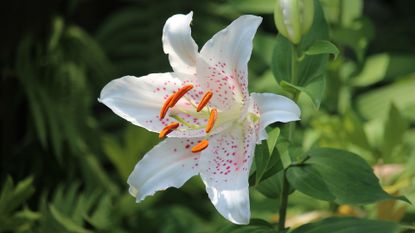How to care for Easter lilies – tips for growing lilium longiflorium
Follow these tips on how to care for the Easter lily – whether you are growing it inside or in your backyard


Learn how to care for Easter lilies and you can extend the life of these outstanding blooms. With their large trumpet-shaped, pure white flowers, lilium longifolium – as they are botanically known – are synonymous with mid spring and for Christians they have long been symbolic of purity and rebirth. The blooms open to reveal central golden anthers and fill the air with a delicious, sweet scent.
Reaching up to 3ft (1m) tall Easter lilies make a striking statement both in pots and borders, so it’s well worth knowing how to care for them so you can enjoy these most eye-catching of flower bed ideas for years to come. Our expert guide has easy-to-follow advice.
How to care for an Easter lily indoors
Mid spring stores and supermarkets are full of potted Easter lilies clamoring to be snapped up and taken home to be included in our Easter decorations. Available in both plastic nursery pots and more decorative ceramic planters, their lush leafy stems are usually topped with plump buds or fresh first blooms.
Look for healthy, strong plants with bright green leaves and plenty of full buds – as this is the number of spectacular blooms you can expect to enjoy.
Check the base of the pot too – if one or two wispy roots are escaping that’s the sign of a well-established, thriving plant. If lots of roots are protruding – particularly thick ones – then the lily is pot bound and stressed and urgently needs repotting. Something that’s pretty easy to do but not ideal, especially if being gifted.
Be careful not to knock any buds off when transporting the plant – they tend to be rather delicate – and keep protected from any sudden icy blasts, as this can shock the plant after lazing in the warmth of a store.
Where to position an Easter lily indoors
Easter Lilies like a bright spot but out of direct sunlight, so they are best kept near a window. Temperatures around a comfortable 65-75℉ (18-23℃) are ideal.
Although beautiful, lily pollen – the sticky, golden dust at the end of the anthers – can seriously aggravate allergies and cause wheezing and itchy eyes, so it’s best to remove this part of the flower as soon as you get the plant home. Simply snip off each anther at the base with a pair of small sharp scissors and keep a close watch for others as new blooms unfurl.
Lily pollen is also a nightmare for staining fabrics and pale surfaces, leaving unsightly spots and smears. Almost impossible to remove, give yourself peace of mind by quickly removing the pollen source.
It’s also worth knowing that lily pollen is poisonous to many domestic pets, including cats so be safe and snip off the anthers and place the blooms well out of reach.
How much water does an indoor Easter lily need
When it comes to watering, these flower bulbs hate sitting in water, so be sure to keep the soil damp but not sodden. An easy way to check this is to push a finger down into the compost making sure it’s not just the surface that is moist.
How to care for an Easter lily planted in a border
Standing tall with their showy flowers, white Easter lilies look stunning planted in clumps near to a seating area, entranceway or along a path where their delicious fragrance can be most appreciated. Suited to growing in USDA hardiness zones 4-8 they need little care if thoughtfully planted.
'Lily "bulbs" are actually tubers composed of fleshy scales and lack a protective covering,' say the folks at bulb specialist Breck’s. ‘Unlike true bulb flowers, they never go completely dormant and should be handled carefully since they lose moisture very quickly.’
As with many late spring flowering bulbs you can either plant lily bulbs in fall or early spring. The team at Crocus say: ‘Planting in fall often helps them settle in and become better established before they start to put on their new spring growth, but spring planting is a better option if your soil is heavy and wet during winter.’
Preferring a sunny spot, Longiflorum lilies tend to grow best in neutral to alkaline soils such as chalk, clay, loam and sand. They love to sink their roots into well drained soil, so it’s well worth digging in some well-rotted compost before planting the bulbs in group of three or more. Conklyn's, the US' biggest grower of Easter lilies, says,’ If you plant your Easter lily outside, cover the roots with mulch to help keep them shaded.’
Plant at twice the depth of the bulb to encourage strong, well supported growth and to also give shoots the chance to avoid being frosted. As tall plants these beauties will need support, so either stake with bamboo canes or grow-through plant supports.
When it comes to watering lilies like damp soil and will rot if left sitting in wet conditions.
How to care for an Easter lily grown in a container
Easter lilies look spectacular grown in a larger planter and the advantage is that they can be proudly moved to a prominent spot – such as a front porch or entranceway – as they come into bloom.
Good drainage and a generous sized pot are key to success. Guy Barter at RHS says to, ‘Grow lilies in containers or under glass grow in loam-based potting compost (JI No.2) with added grit and leaf mould in full light with shade from hot sun.’
Sarah Raven, cut flower grower and plant trialist suggests, ‘Lilies like to be fed while they are growing. Ideally give them a liquid potash feed (e.g. tomato feed) every two weeks as well as top dressing with a slow release fertilizer.’
Once the flowers have faded, snip the stem back to just above a pair of leaves, this will then feed the bulb for the following season.
What do you do with Easter lily after they've flowered?
How does Easter lily care continue after the plant has finished flowering? If your Easter lily is indoors, you can plant it outside to continue to enjoy its blooms next season. To do this:
- Wait until the last frosts have passed, which can vary zone-to-zone.
- With the plant intact, remove it from its container. Once planted, its leaves will die back, but new shoots will come if you follow the care tips below.
- Plant it in a sunny position in well-drained soil; dappled afternoon shade will benefit the Easter lily all the more.
- Water and fertilize the newly-planted Easter lily.
- Mulch to keep roots protected and fed.
- Cut back stems in fall once the leaves have died back again.
- Top up the mulch to protect your plant over winter; wait for new shoots in spring.
Sign up to the Homes & Gardens newsletter
Decor Ideas. Project Inspiration. Expert Advice. Delivered to your inbox.

Jill Morgan has spent the last 20 years writing for Interior and Gardening magazines both in print and online. Titles she has been lucky enough to work on include House Beautiful, The English
Home, Ideal Home, Modern Gardens and Gardeningetc.com. Although much of her career has involved commissioning and writing about reader homes and home improvement projects, her
everlasting passion is for gardens and outdoor living, which is what she writes about for Homes & Gardens.
-
 Retro kitchens are back – here's 12 ways designers create characterful spaces with a touch of nostalgia
Retro kitchens are back – here's 12 ways designers create characterful spaces with a touch of nostalgiaChannel Mid-century modern design and vintage style with these retro kitchen ideas
By Pippa Blenkinsop Published
-
 How to remove odors from upholstery – to turn your furniture from musty to marvelous
How to remove odors from upholstery – to turn your furniture from musty to marvelousProfessional cleaners reveal the five best ways to remove odors from upholstery to keep your home smelling fresh and make your furniture last longer
By Chiana Dickson Published